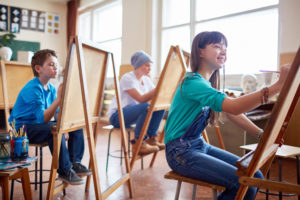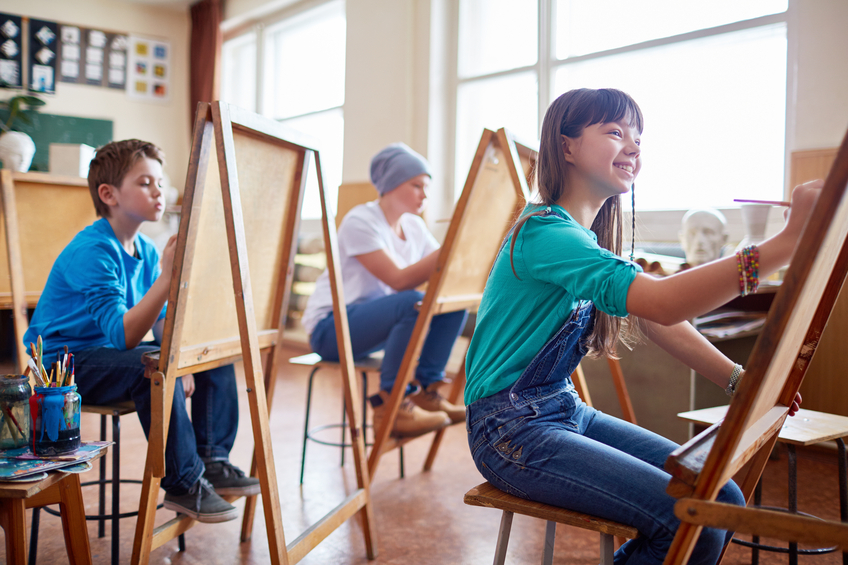

With an increase in English Language Arts standards focused on informational, exploratory, persuasive, or even narrative writing, students often do not get a significant amount of time for playful creative writing. In the early years, experimenting with ideas and creativity can help young writers develop a nimbleness with language that imbues their nonfiction work with fun and quirkiness.
Students should experience the joy of writing while they develop ELA skills
A summer workshop focused on imagination unleashes students’ creative side and challenges them to add some extra “oomph” to their writing while simultaneously building ELA skills. Even better, they learn that there is joy to be had in the act of writing.
Playful creative writing lessons teach plot development, sequencing and audience awareness
Students who practice creative writing learn about sequencing and plot development, but also about the importance of supporting details and a well-turned phrase. These skills transfer readily to nonfiction writing and expand students’ ability to gain and maintain reader attention, craft an understandable piece of writing, and bring creativity to their critical thinking. If a creative workshop is paired with a nonfiction writing assignment, young writers may discover that many creative writing tools help them craft strong essays as well.
Word portraiture: A summer workshop to stretch students’ writerly imaginations
This writing workshop, inspired by author Jennifer Traig’s “Word Portraiture” exercise in “Don’t Forget to Write for the Secondary Grades: 50 Enthralling and Effective Writing Lessons,” requires little in the way of preparation other than finding a fun model — perhaps a friend or fellow teacher — who is willing to wear a unique outfit. While initially designed for elementary writers, the workshop could be easily adapted for middle or high school students.
Introducing the concept of portraiture
Before the lesson, it’s a good idea to introduce students to the concept of portraits, looking at several together. To help prepare them for their task, briefly introduce some basic requirements for creating word portraits, such as:
- Figurative language
- Lots of details
- Description based on observation
Reading a book excerpt with an excellent character description can be another good preparation tool for your class. While it might be helpful to do this a day or two in advance, these discussions can also be conducted at the beginning of the workshop.
20-minute modeling and ‘sketching’ period focused on observation and detail
On the day of the workshop, have your quirkily dressed model enter and quietly move to the front of the room. Traig noted that in one of her sessions, “this particular model sported a lovely burgundy velvet dress, tasteful heels, and a Dali-esque handlebar mustache.”
The model can sit still or engage in a quiet activity during the 20-minute modeling period while students “sketch” him or her by taking as many notes as they can to help with description. Students can make inferences about the character’s personality, job, or hobbies based on what they see or don’t see. During this time, challenge them to write down detailed notes and make guesses rather than focusing on the writing itself.
Writing time: Challenge students to turn their impressions into a compelling story
After the observation period, have students turn their notes into a short snapshot or story that describes their impression of the model. Traig suggests giving workshop participants options for styles to follow, which might include:
- Caricature, a hyperbolic description of one or two of the character’s features
- Advertisement, an “over-the-top and cheesy as all get-out” sales pitch for the character
- Negative relief, writing about only what the author didn’t observe
Sharing, collaboration and revision to strengthen the writing process
Once they have finished a first draft, encourage students to share either with the class as a whole or in small groups. Students should read their writing out loud to their group or class and are welcome to make notes or revise while doing so. During this sharing time, they should be encouraged to look for great descriptions or turns of phrase in their classmates’ writings and make sure to compliment them when they hear it.
This part of the exercise is important because it increases collegiality and collaboration in the writing process and adds a fun element to the work. Students leave the workshop with not only an understanding of description and details, but an idea of their strengths as writers and, hopefully, a great written description of their costumed model.
Applying word portraiture techniques to informational and nonfiction writing
There are two interesting ways to expand the potential of this workshop to include nonfiction writing. In the first, students can be tasked with creating a word portrait of someone they love and incorporating it into a piece of narrative writing. Alternatively, teachers can fold this workshop into informational writing by focusing on an image of a person or event for their descriptive exercise.
This provides a perfect opportunity to transfer those descriptive and figurative language skills to help students create engaging openings for informational writing about a person or event. In order to do this, it’s best to provide excellent photographs of the person or event for students rather than leave it up to chance.
Essential writing skills benefit from exercises in adventure
Whether it’s tied into a larger writing unit or not, a creative writing workshop on word portraits can bring some levity to the classroom while teaching students essential writing skills. Because so much writing instruction is focused on developing nonfiction composition, freeing up everyone’s minds with a creative adventure can be time well spent.
Monica Fuglei is a graduate of the University of Nebraska in Omaha and a current faculty member of Arapahoe Community College in Colorado, where she teaches composition and creative writing.
Categorized as: Tips for Teachers and Classroom Resources
Tagged as: Art, Engaging Activities, Language Arts
